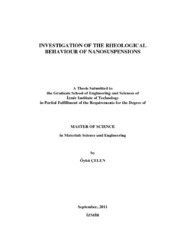Please use this identifier to cite or link to this item:
https://hdl.handle.net/11147/3145Full metadata record
| DC Field | Value | Language |
|---|---|---|
| dc.contributor.advisor | Çiftçioğlu, Muhsin | en |
| dc.contributor.author | Çelen, Öykü | - |
| dc.date.accessioned | 2014-07-22T13:50:58Z | - |
| dc.date.available | 2014-07-22T13:50:58Z | - |
| dc.date.issued | 2011 | en |
| dc.identifier.uri | http://hdl.handle.net/11147/3145 | - |
| dc.description | Thesis (Master)--Izmir Institute of Technology, Materials Science and Engineering, Izmir, 2011 | en |
| dc.description | Includes bibliographical references (leaves:118-121) | en |
| dc.description | Text in English; Abstract: Turkish and English | en |
| dc.description | xix, 121 leaves | en |
| dc.description.abstract | The rheology of concentrated calcium carbonate, titania, silica, alumina and zirconia suspensions of submicron/nanosized particles in non-aqueous media was investigated. Calcium carbonate and silica particles were synthesized by carbonation route and Stöber method respectively while titania, alumina and zirconia powders were obtained commercially. Suspensions of the ball milled natural calcium carbonate powders were also prepared. The dispersion of these powders especially at high solids loadings was observed to be difficult. The viscosity of the 45 vol% suspensions of precipitated CaCO3 particles increased about 21 times at a shear rate of 400 sec-1 relative to its initial value indicating shear-thickening behaviour. The onset of shear thickening was at 20, 30 and 40 vol% for three different commercial titania powder suspensions. The onset of shear thickening was at lower solids volume contents and the increase in viscosity with shear rate was far less dramatic for the titania suspensions with polydispersed particle size distributions. The critical shear rate was 187 sec-1 for silica suspensions at 47 vol% with a discontinuous jump in viscosity. Rheological data at higher shear rates was not obtained due to the torque limitations of the rheometer. The critical shear rate of the polydispersed alumina powder suspensions were higher than their relatively monodispersed counterparts. The highest solids loading achieved in alumina based suspensions was 62 vol%. The dynamic shear rheology measurements showed that the solid part of the silica suspension was becoming more dominant over the liquid part as the solid content was increased. The volume fraction dependence of the high shear viscosity was fitted to a modified Krieger-Dougherty model for titania and silica suspensions. The fit of the rheological data to the Power law and to a modified version of Cross model were analysed. | en |
| dc.language.iso | en | en_US |
| dc.publisher | Izmir Institute of Technology | en |
| dc.rights | info:eu-repo/semantics/openAccess | en_US |
| dc.subject.lcsh | Suspensions (Chemistry) | en |
| dc.subject.lcsh | Nanostructured materials | en |
| dc.subject.lcsh | Rheology | en |
| dc.title | Investigation of the rheological behaviour of nanosuspensions | en_US |
| dc.type | Master Thesis | en_US |
| dc.institutionauthor | Çelen, Öykü | - |
| dc.department | Thesis (Master)--İzmir Institute of Technology, Materials Science and Engineering | en_US |
| dc.relation.publicationcategory | Tez | en_US |
| item.openairecristype | http://purl.org/coar/resource_type/c_18cf | - |
| item.cerifentitytype | Publications | - |
| item.fulltext | With Fulltext | - |
| item.languageiso639-1 | en | - |
| item.grantfulltext | open | - |
| item.openairetype | Master Thesis | - |
| Appears in Collections: | Master Degree / Yüksek Lisans Tezleri | |
Files in This Item:
| File | Description | Size | Format | |
|---|---|---|---|---|
| T000955.pdf | MasterThesis | 11.98 MB | Adobe PDF |  View/Open |
CORE Recommender
Page view(s)
136
checked on Apr 15, 2024
Download(s)
54
checked on Apr 15, 2024
Google ScholarTM
Check
Items in GCRIS Repository are protected by copyright, with all rights reserved, unless otherwise indicated.